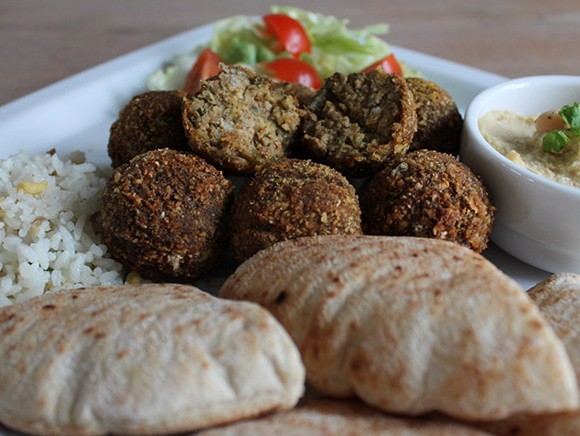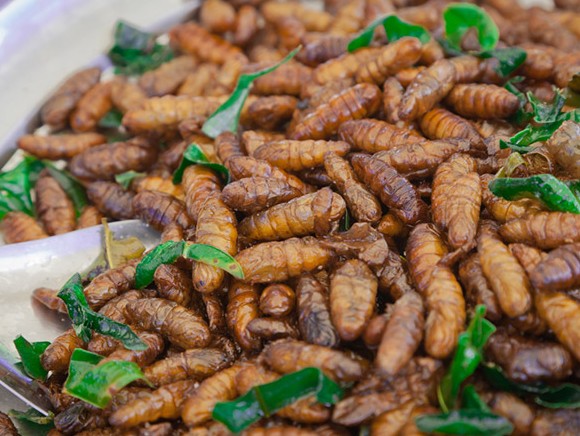
A few people have tried it, most people have heard about it, everyone has an opinion on it and the majority of Dutch consumers shudder at the thought. Why should you eat insects? Because they are a sustainable source of protein!
Based on the latest estimates, the world population will be between 7 and 11 billion in 2050. If we are to feed all those mouths, we will need to add other protein sources to the conventional ones of cattle, pigs, sheep and poultry. That’s why scientists are fervently searching for alternative sources of protein: algae are gaining in popularity, there is a growing focus on nuts and pulses, and insects are also on the list as ‘mini livestock’.
There is a rich variety of insects worldwide, and some of them can be reared. That involves countless challenges, and knowledge and experience is still limited. How can you rear insects hygienically on a large scale and cost-effectively? What’s the situation in terms of safety, toxicity and allergies? (To answer that last question, an allergy study has been set up in conjunction with TNO and Utrecht University.) What are the legal requirements and restrictions? Can insects or insect-based ingredients be used as a foaming, gelling or emulsifying agent? Which products offer the most potential? And perhaps the most important challenge: how can consumers be persuaded to regard insects as an acceptable source of protein? There are lots of questions and lots of obstacles, but also a whole range of opportunities, which can be summarised as: lower greenhouse gas emissions, efficient conversion of feed into protein, and more efficient use of the available space.
Insects are cold blooded, which means that they generally have a higher feed conversion efficiency than warm-blooded mammals. Less energy is ‘wasted’ on maintaining their body temperature, which means that more energy can be directed towards growth. Insects consume less water and less land per kilo of edible product and they produce smaller quantities of greenhouse gases than cows, chickens or pigs. Furthermore, ‘conventional’ livestock farming has been the subject of optimisation for years – extensive research has been conducted into breeds, feed, rearing methods, etc. – whereas the insect industry is still in its infancy. Hence, as insect farming increasingly takes off, there is the potential for many efficiency gains.
There is no such thing as ‘the insect’; there is a huge diversity of types. Because it is impossible to generalise about the whole group, we will zoom in on a few specific types here.
It takes just eight weeks for mealworms to reach the stage at which they can be ‘harvested’ (i.e. just before they metamorphose into meal beetles). Their nutritional composition is not bad: they contain a comparable amount of protein per kilo of edible product to beef (20%) and a third more fat (12% – which could merit extra consideration, especially in developed countries), as well as a similar amount of saturated fat to beef (3%) and less sodium (50mg/100g)3. In addition to this favourable nutrition profile, the mealworm emits less than 10g of CO2 per kg of increase in body weight, compared with more than 80g for pigs and around 2,500g for cattle (again, depending on the rearing method, breed, etc).(1)
‘A lot of research is currently focused on isolating useful components from insects’
The cricket also scores well in comparison with meat, although rearing them takes a little longer than mealworms (9-10 weeks).(2) The fat percentage of the cricket is approximately a third lower than that of beef (5%) and the sodium level is higher (150mg/100g).(3) At 1.5g/kg increase in body weight, its CO2 production is even lower than that of the mealworm.(1)
Armed with such positive nutritional values and sustainability characteristics, it’s not surprising that insect-rearing initiatives are springing up everywhere like mushrooms after the rain (which are also a high-potential source of protein by the way!). The approach of such initiatives varies widely but it is precisely that diversity that gives insect farming a real chance of success.
Let’s turn our focus to places where insects have been a source of food for centuries, such as in Africa where there is a tremendous need for high-quality, protein-rich food. Along the shores of Lake Victoria, in both Kenya and Uganda, a value chain for cricket consumption is currently being established including small-scale cricket farming, processing and marketing.(4) And although, even there, crickets are not (yet) a general component of the local diet, the first signs emerging from consumer studies have been positive. The possibilities for large-scale cricket farming in these countries are already being considered – initially for the local population, but...who knows? Perhaps export could also be an option in the future.
‘As insect farming increasingly takes off, there is the potential for many efficiency gains’
Closer to home, in Finland, the government is funding the ScenoProt (5) project that is aimed at increasing the country’s self-sufficiency in terms of protein production. The 6-year project should result in ways of protein being produced more locally. The research is focused on plant production, animal feed, process technology, the health aspects of the food and the environmental impact.

Edible insects remain a niche market for now, partly because of the price (due to the
Small-scale and labour-intensive process involved, insects for human consumption are relatively expensive) and partly due to low consumer acceptance, because – although insects can be eaten whole – it really is a step too far for many Westerners. That’s why a lot of research is currently focused on isolating useful components from insects and investigating how they can be used as functional ingredients such as foaming, gelling or emulsifying agents. It is already possible to recover high-quality ingredients from algae and vegetable waste at medium scale, including in the mobile biorefinery called Valorie.(6) The insights can be replicated, but isolating insect ingredients demands different techniques than biorefining algae does. The Netherlands is leading the way in biorefining, with TNO, the International Insect Centre (IIC) and Wageningen University all working on projects. The Netherlands also has a number of large insect farmers plus dozens of smaller ones, and there is even an industry association for them called Venik. In addition, numerous innovative products have been developed (such as the Buqadilla developed by Ruig in Oostzaan) and insect burgers are already on sale in various supermarkets. In other words: the time is ripe for a sustainable future full of interesting new products!
(1) Ooninx et al., PloS ONE (2010) 5 (12), e14445.
(2) Booth et al, Journal of Insect Physiology (2007), 53, 950-953
(3) Payne et al., European Journal of Clinical Nutrition (2016) 70, 285-291
(4) www.flyingfoodproject.com
(5) https://www.luke.fi/scenoprot/
(6) https://www.tno.nl/nl/aandachtsgebieden/industrie/sustainable-chemical-industry/feedstock-flexibility/algen-voor-een-duurzame-toekomst/
Source: Foto's: ©Jannarong/Shutterstock.com; ©NuanyaiH/Shutterstock.com